Trees and Shrubs in a Pollinator-Friendly Yard
Insects are among nature’s more industrious workers, ensuring generations of bountiful and useful plants. We can help them do their work by creating a more pollinator-friendly yard. And when we do so, trees and shrubs have a strong role to play.
There are already many other benefits of trees. They serve as a carbon sink, helping to combat climate change by absorbing carbon dioxide. They mitigate the urban heat island effect, providing cooling shade. This has implications for heat stroke, asthma and other health problems. A sun-loving serviceberry might provide a canopy from 15- to 30-feet in diameter; maple or oak also serve as reliable shade trees providing upwards of 50- or 60-feet diameter cooling effects. And the canopy layer provided by a tree enhances the aesthetic appeal of a yard.
But many people don’t know how well trees shoulder the work in their ecosystem, adding value for wild bees and other pollinators. An oak tree, for example, supports many types of bird, caterpillar and insect species.
To support pollinators, a garden should have plants with staggered bloom times so pollen is readily available. During the spring, many flowering trees offer early food sources. In fact, a flowering tree can provide as much forage during the spring as an entire garden, according to Planting for Pollinators, a guide on creating residential pollinator habitat from Minnesota Board of Water and Soil Resources (BWSR). Crabapple, hawthorn, pagoda dogwood and plum (pictured here) are just a few examples that provide well for pollinators.
As far as choosing trees, remember that Minnesota stretches into three general planting zones, or biomes: Prairie (south and west), Coniferous (north) and Basswood (east). Choose from native species of flowering trees and shrubs that have co-evolved with local pollinators, adapting to each other, winter snow and summer heat, and natural predators. Again, BWSR’s Planting for Pollinators guide provides some ideas.
Finally, when thinking about the impact of your efforts to protect pollinators in your yard, remember that your efforts can play a role in a larger corridor of connected habitat. “Every homeowner can help rebuild pollinator corridors and one of the biggest impacts to achieve this would be adding trees and shrubs,” says Jennifer Moeller, a landscape designer and former project manager at Metro Blooms.
— Ken Jopp, St. Paul-based freelance writer
Additional Resources:
- Planting for Pollinators, downloadable guide from MN Board of Water and Soil Resources. Look for the section on trees and shrubs.
- Pollinator Beneficial Trees and Shrubs, overview from Blue Thumb
- “Trees improve human health and well-being in many ways,” in Research Review, US Forest Service Northern Research Station, April 2015.
- Trees and shrubs are one of many topics covered in our Blue Thumb Resilient Yards workshops, offered via webinar. Other topics include site planning, rain gardens native planting, protecting pollinators, and more.
- The Benefits of Trees, from the non-profit Canopy, summarizes how trees help in our urban settings.

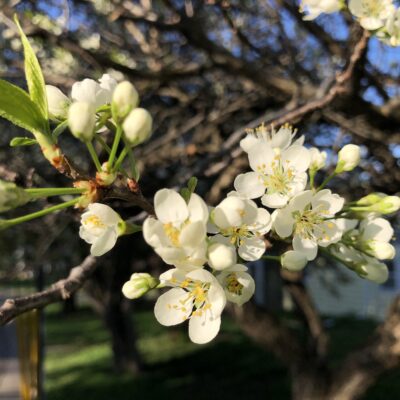
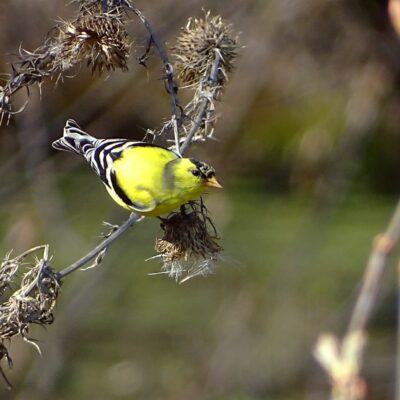
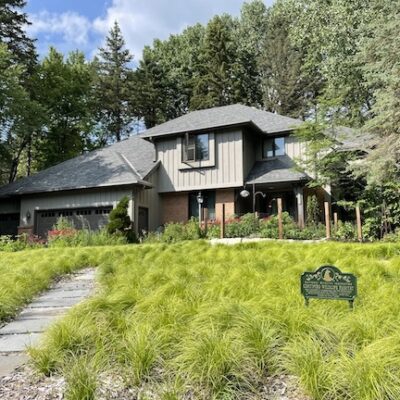
 Volunteering as a Minnesota Master Naturalist in the Blue Thumb booth at the MN State Fair several years ago planted the seed for this project. Then I read Douglas Tallamy’s book,
Volunteering as a Minnesota Master Naturalist in the Blue Thumb booth at the MN State Fair several years ago planted the seed for this project. Then I read Douglas Tallamy’s book, 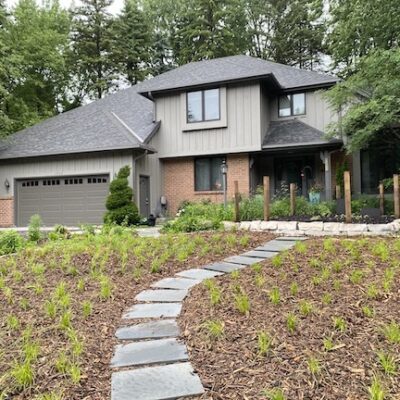
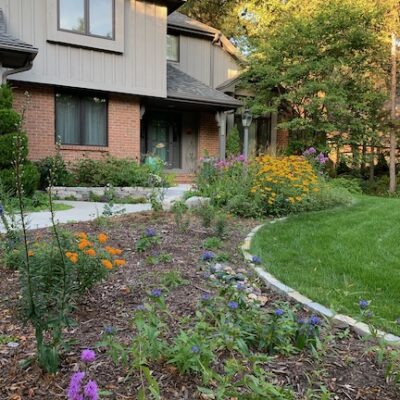 The main front yard work was done last summer and, already, the yard looks lush and healthy — despite the intensely hot and dry summer. I know that some people in the neighborhood were initially thrown by the difference of my yard, but it seems from comments this year that they’re okay with it, now that the sedges have grown together to create a more uniform look. Others — especially younger homeowners and those with kids — were enthusiastically supportive from the start. It’s ever clearer that this is about changing culture, and that takes time and a gentle but firm hand in leading that within a conventional context.
The main front yard work was done last summer and, already, the yard looks lush and healthy — despite the intensely hot and dry summer. I know that some people in the neighborhood were initially thrown by the difference of my yard, but it seems from comments this year that they’re okay with it, now that the sedges have grown together to create a more uniform look. Others — especially younger homeowners and those with kids — were enthusiastically supportive from the start. It’s ever clearer that this is about changing culture, and that takes time and a gentle but firm hand in leading that within a conventional context. 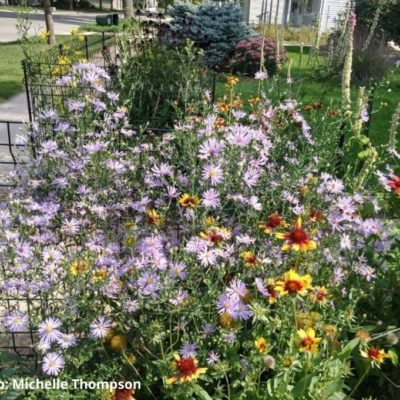
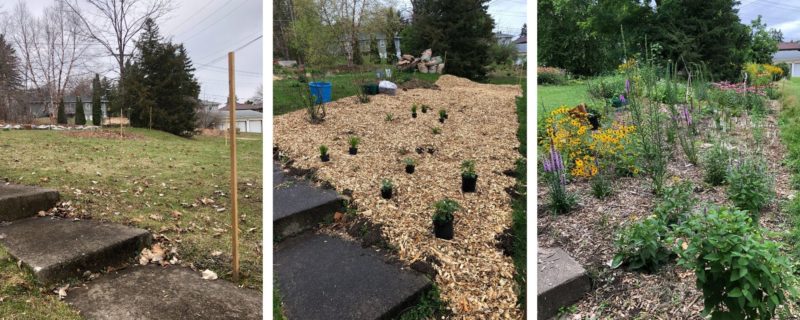
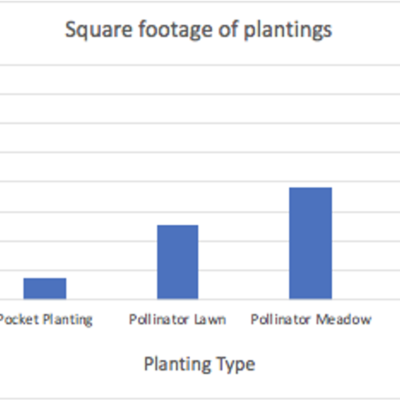


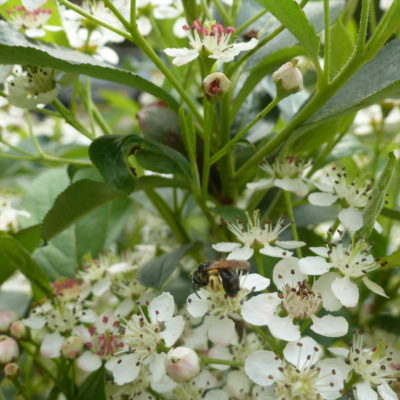
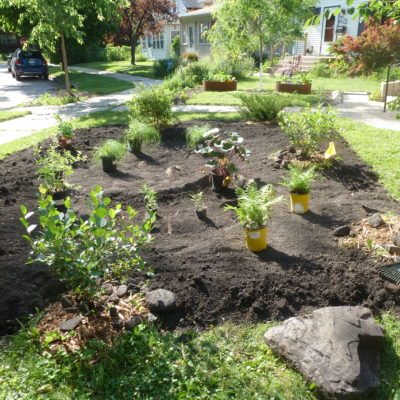 I had the good fortune to move next door to a landscape architect. Though retired, she was willing to take on small design projects for friends and neighbors. She and I had been collaborating on a plan for a pollinator-encouraging garden also capable of filtering water that feeds into the nearby Mississippi River. Unexpectedly, this gave me some parameters when the opportunity arose to apply to the Lawns to Legumes cost-share program.
I had the good fortune to move next door to a landscape architect. Though retired, she was willing to take on small design projects for friends and neighbors. She and I had been collaborating on a plan for a pollinator-encouraging garden also capable of filtering water that feeds into the nearby Mississippi River. Unexpectedly, this gave me some parameters when the opportunity arose to apply to the Lawns to Legumes cost-share program. Thankfully, the Cities are in a Zone 4 growing region, meaning that my approved plan didn’t have to be implemented until the end of the academic year. Work resumed after virtual commencements. I confirmed utility lines and neonicotinoid-free growers, ordered some trees and shrubs for delivery and – shielded in homemade mask, plant/shrub list in sanitized hands – purchased the rest at local nurseries.
Thankfully, the Cities are in a Zone 4 growing region, meaning that my approved plan didn’t have to be implemented until the end of the academic year. Work resumed after virtual commencements. I confirmed utility lines and neonicotinoid-free growers, ordered some trees and shrubs for delivery and – shielded in homemade mask, plant/shrub list in sanitized hands – purchased the rest at local nurseries.
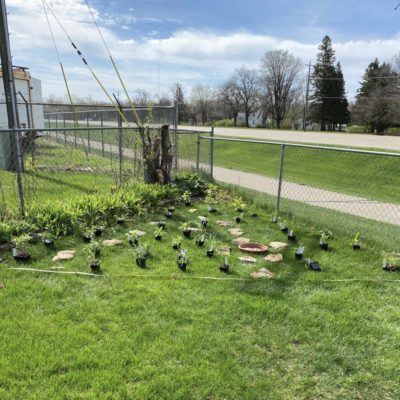 I marked off the pocket garden plot. Then I laid out the flowers in their pots on the plot to get a visual of where they would be planted. I took a picture so I would know where to plant them later on.
I marked off the pocket garden plot. Then I laid out the flowers in their pots on the plot to get a visual of where they would be planted. I took a picture so I would know where to plant them later on. 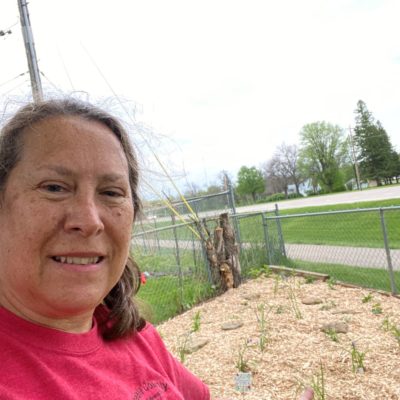 A few weeks later, the plants looked stronger and bigger. Some even had flowers. I have not seen any bumblebees around the pocket garden yet, but I know they will appreciate the flowers, which will be blooming until late fall this year.
A few weeks later, the plants looked stronger and bigger. Some even had flowers. I have not seen any bumblebees around the pocket garden yet, but I know they will appreciate the flowers, which will be blooming until late fall this year.